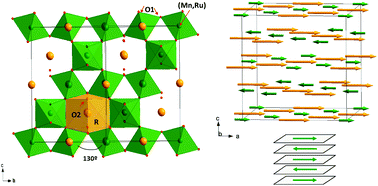Evolution of the crystal and magnetic structure of the R2MnRuO7 (R = Tb, Dy, Ho, Er, Tm, Yb, Lu, and Y) family of pyrochlore oxides
Abstract
The members of the family of pyrochlore oxides with the formula R2MnRuO7 (R = Tb, Dy, Ho, Er, Tm, Yb, Lu and Y) have been synthesized and characterized. Polycrystalline samples were prepared by a soft chemistry procedure involving citrates of the different metal ions, followed by thermal treatments in air or O2 pressure. The crystallographic and magnetic structures have been analysed from ![[3 with combining macron]](https://www.rsc.org/images/entities/char_0033_0304.gif) m, which defines an intrinsic frustrated three-dimensional system. In all the cases, the low-temperature NPD data unveils an antiferromagnetic coupling of two subsets of Mn4+/Ru4+ spins, indicating that the magnetic frustration is partially relieved by the random distribution of Mn and Ru over the 16c sites. At lower temperatures there is a polarization of the R3+ magnetic moments, which also participate in the magnetic structure, when a magnetic rare earth is present.
m, which defines an intrinsic frustrated three-dimensional system. In all the cases, the low-temperature NPD data unveils an antiferromagnetic coupling of two subsets of Mn4+/Ru4+ spins, indicating that the magnetic frustration is partially relieved by the random distribution of Mn and Ru over the 16c sites. At lower temperatures there is a polarization of the R3+ magnetic moments, which also participate in the magnetic structure, when a magnetic rare earth is present.


 Please wait while we load your content...
Please wait while we load your content...